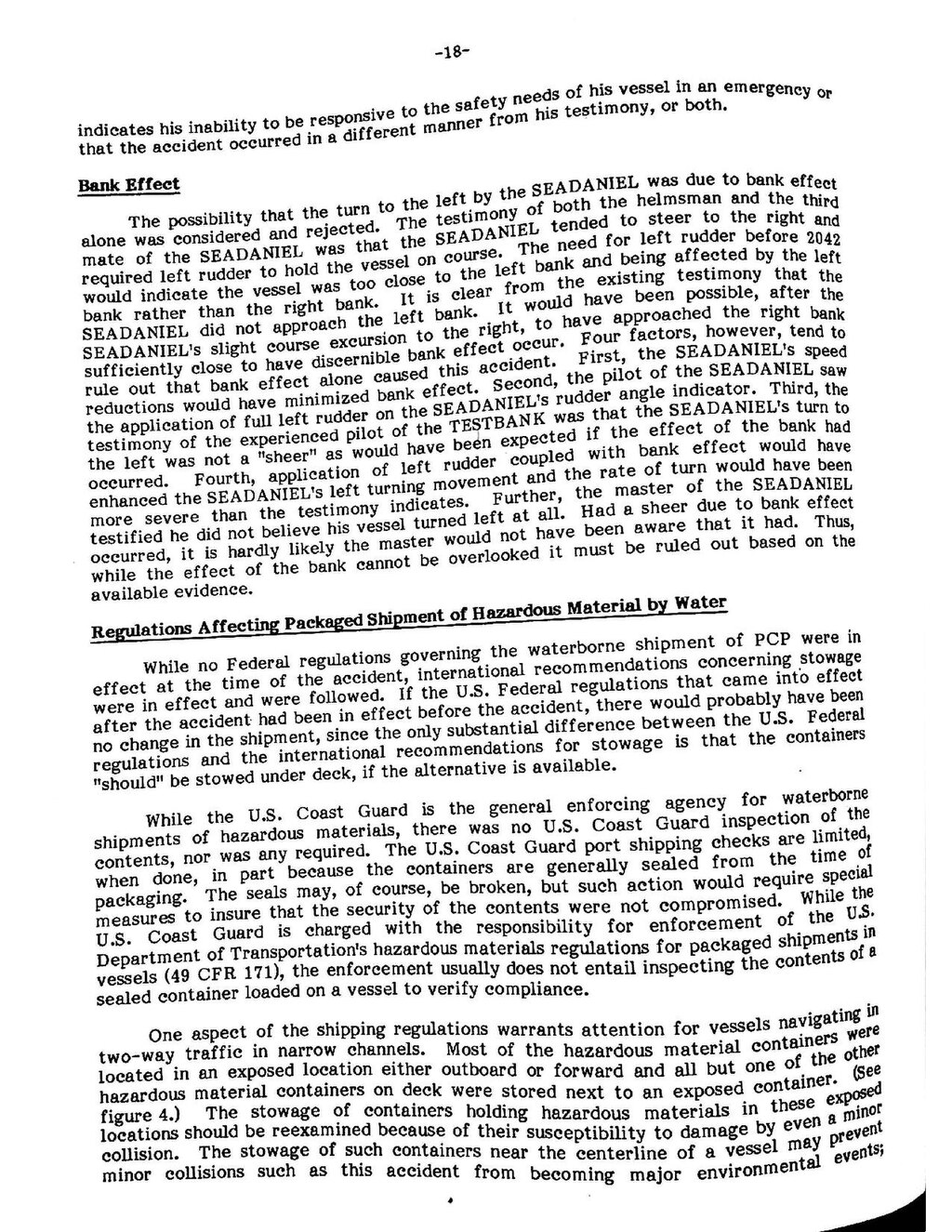indicates his inability to be responsive to the safety needs of his vessel in an emergency or that the accident occurred in a different manner from his testimony, or both.
Bank Effect
The possibility that the turn to the left by the Seadaniel was due to bank effect was considered and rejected. The testimony of both the helmsman and the third mate of the Seadaniel was that the Seadaniel tended to steer to the right and required left rudder to hold the vessel on course. The need for left rudder before 2042 would indicate the vessel was too close to the left bank and being affected by the left bank rather than the right bank. It is clear from the existing testimony that the Seadaniel did not approach the left bank. It would have been possible, after the Seadaniel's slight course excursion to the right, to have approached the right bank sufficiently close to have discernible bank effect occur. Four factors, however, tend to rule out that bank effect alone caused this accident. First, the Seadaniel's speed reductions would have minimized bank effect. Second, the pilot of the Seadaniel saw the application of full left rudder on the Seadaniel's rudder angle indicator. Third, the testimony of the experienced pilot of the Testbank was that the Seadaniel's turn to the left was not a "sheer" as would have been expected if the effect of the bank had occurred. Fourth, application of left rudder coupled with bank effect would have enhanced the Seadaniel's left turning movement and the rate of turn would have been more severe than the testimony indicates. Further, the master of the Seadaniel testified that he did not believe his vessel turned left at all. Had a sheer due to bank effect occurred, it is hardly likely the master would not have been aware that it had. Thus, while the effect of the bank cannot be overlooked it must be ruled out based on the available evidence.
Regulations Affecting Packaged Shipment of Hazardous Material by Water
While no Federal regulations governing the waterborne shipment of PCP were in effect at the time of the accident, international recommendations concerning the stowage were in effect and were followed. If the U.S. Federal regulations that came into effect after the accident had been in effect before the accident, there would probably have been no change in the shipment, since the only substantial difference between the U.S. Federal regulations and the international recommendations for stowage is that the containers "should" be stowed under deck, if the alternative is available.
While the U.S. Coast Guard is the general enforcing agency for waterborne shipments of hazardous materials, there was no U.S. Coast Guard inspection of the contents, nor were any required. The U.S. Coast Guard port shipping checks are limited, when done, in part because the containers are generally sealed from the time of packaging. The seals may, of course, be broken, but such action would require special measures to insure that the security of the contents were not compromised. While the U.S. Coast Guard is charged with the responsibility for enforcement of the U.S. Department of Transportation's hazardous materials regulations for packaged shipments in vessels (49 CFR 171), the enforcement usually does not entail inspecting the contents of a sealed container loaded on a vessel to verify contents.
One aspect of the shipping regulations warrants attention for vessels navigating in two-way traffic in narrow canals. Most of the hazardous material containers were loaded in an exposed location either outboard or forward and all but one of the other hazardous material containers on deck were stored next to an exposed container. (See figure 4.) The stowage of containers holding hazardous materials in these exposed locations should be reexamined because of their susceptibility to damage by even a minor collision. The stowage of such containers near the centerline of a vessel may prevent minor collisions such as this accident from becoming major environmental events;
